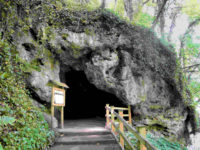Joshua 4:21-22
“And he spake unto the children of Israel, saying, When your children shall ask their fathers in time to come, saying, What mean these stones? Then ye shall let your children know, saying, Israel came over this Jordan on dry land.”
 It is generally assumed by schoolteachers and the media that fossilization is a painfully slow process. In fact, there are many contemporary evolutionists who know that fossilization can be much more rapid, but the popular timescale suggests that the process requires millions of years.
It is generally assumed by schoolteachers and the media that fossilization is a painfully slow process. In fact, there are many contemporary evolutionists who know that fossilization can be much more rapid, but the popular timescale suggests that the process requires millions of years.
Yet, it defies logic to suppose that a large fossil could be stuck out of the ground for millions of years without rotting, while it gets slowly covered in sediment. If a large fossil is enclosed in a layer, then it is likely that the whole layer was formed rapidly; otherwise, the bones would have rotted away before any permineralization could take place.
In the Mount St Helens Creation Center, we have a petrified teddy bear which was given to the Center. It came from Mother Shipton’s Well in Yorkshire, England. At this well-known mineralization cave, objects like teddy bears, hats, and ties are hung on threads, so that the calcite-rich cave water can drip on to them. A typical teddy bear takes six months to turn to stone in these conditions.
Careful researcher, Dr. Vij Sodera, has catalogued many examples of rapid fossilization in his wonderful book, One Small Speck. In just half a dozen pages, we see fossils of exoskeletons, shed by arthropods, a human footprint, fossilized in the year 2000, and a tree trunk, whose rings show it was fossilized in less than 2,400 years. Dr. Sodera shows that such rapid fossilization is the norm, not the exception, and that the process is, therefore, a considerable problem for evolutionists, but not for those who understand the rapid burial of organisms that happened in the Flood. Author: Paul F. Taylor
Prayer: We praise You, heavenly Father, because we know that, when we observe the evidence through the starting point of Your word, then it falls into place and makes sense. Amen.
Ref: Sodera, V. (2009), One Small Speck, pp. 30-36. Image: Creative Commons Attribution 3.0 Unported.
